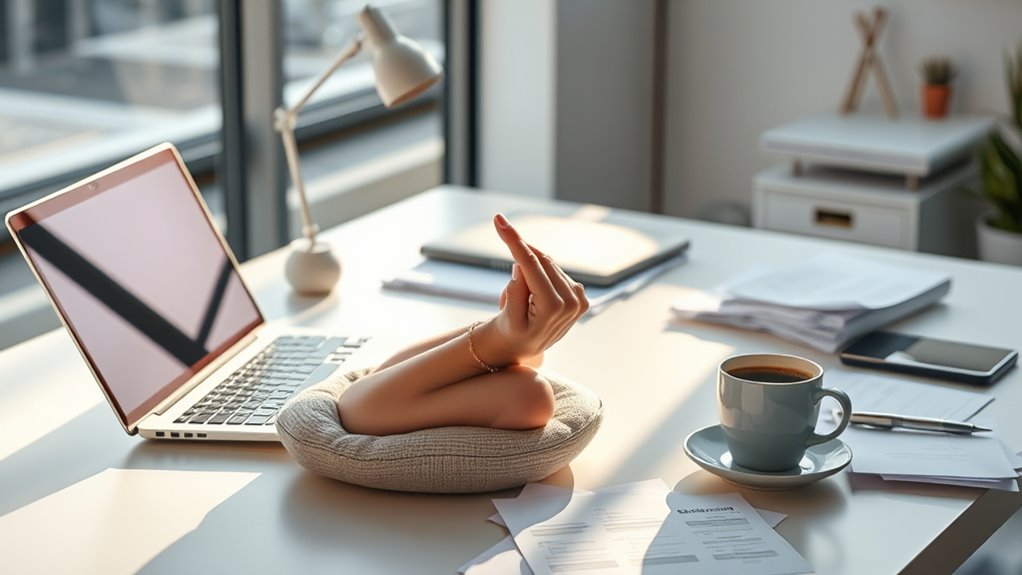Even when you’re pressed for time, quick mindful breathing exercises can help you stay centered. Focus on deep breaths, inhaling through your nose and exhaling slowly through your mouth, paying attention to how the air moves. Use short breaks—like sitting at your desk or waiting in line—to practice muscle relaxation or brief mindful moments. Incorporating these small practices into your daily routine can boost your calmness and clarity — discover more simple ways to fit meditation into busy days.
Key Takeaways
- Practice quick mindful breathing exercises in just a minute to ground and reset your focus.
- Incorporate relaxation techniques during short breaks, like tense-and-release muscle exercises.
- Use tiny moments, such as waiting or commuting, to perform brief mindfulness practices.
- Shift your routine by integrating mindful breaths into daily activities without extra time.
- Participate in workshops or set routines to make meditation a seamless part of your busy schedule.

Ever feel like you just don’t have enough time to meditate? If your schedule’s packed and you’re constantly rushing from one thing to the next, it might seem impossible to carve out even a few quiet minutes. But the good news is, meditation doesn’t need to be a long, dedicated session. You can incorporate mindful breathing and quick relaxation techniques into your busy day, making it easier to find moments of calm when you least expect them.
Start by focusing on mindful breathing, which is one of the simplest ways to center yourself without setting aside extra time. Whenever you’re waiting in line, sitting at your desk, or even commuting, take a deep breath in through your nose, hold it for a couple of seconds, then exhale slowly through your mouth. Pay close attention to the sensation of the air moving in and out, letting your thoughts settle on your breath. This tiny practice can ground you in the present moment and reduce stress instantly, no matter how hectic your day is.
Pause in your day to breathe deeply and focus on the sensation of air—instant calm anywhere, anytime.
Quick relaxation techniques are another effective way to meditate on the go. For example, you can try progressive muscle relaxation while sitting at your desk or during a short break. Tense and then release each muscle group—starting from your toes and working up to your shoulders—focusing on the physical sensations. This method not only relaxes your body but also clears your mind, providing a mental reset in minutes. Incorporating mindfulness practices can further enhance your ability to stay present throughout busy days. Research shows that consistent mindfulness techniques can significantly improve your mood and stress resilience over time.
You don’t need a special space or lengthy periods to benefit from meditation. Even a few mindful breaths taken throughout the day can profoundly improve your mood and focus. When you feel overwhelmed, pause for a moment, close your eyes if possible, and take a series of slow, deliberate breaths. Visualize stress leaving your body with each exhale. These quick mental resets help you regain clarity and calmness, allowing you to tackle your tasks with more ease. Additionally, understanding the importance of consistent practice can help you develop a sustainable routine that fits into your busy schedule.
Incorporating these techniques into your daily routine requires no extra time commitment—just a shift in how you approach small moments. Whether it’s during a coffee break, waiting for a meeting to start, or before bedtime, brief mindful breathing and quick relaxation exercises serve as powerful tools to keep you centered. With consistency, these tiny moments of mindfulness can accumulate, offering you greater resilience and peace, even when your schedule feels impossible to manage.
Additionally, understanding industry trends and continuous training, like participating in workshops and classes, can improve your ability to adapt your meditation practice to busy lifestyles.
Frequently Asked Questions
Can I Meditate While Commuting or Doing Chores?
Yes, you can meditate while commuting or doing chores. Practice mindful listening during conversations or sounds around you, focusing completely on each moment. Try walking meditation, where you pay close attention to each step and your breathing. These techniques help you stay present and centered, even amid busy activities. Incorporating mindful listening and walking meditation into your daily routine makes meditation more accessible, no matter how packed your schedule is.
How Long Should Each Meditation Session Last?
You might wonder about meditation duration, but even short sessions offer mindfulness benefits. Ideally, aim for at least 5 to 10 minutes daily to experience improved focus and stress relief. If you’re pressed for time, even a quick 2-minute breathing exercise can help. Remember, consistency matters more than length, so find a duration that fits your schedule and gradually increase it for deeper mindfulness benefits.
Is It Effective to Meditate With My Eyes Open?
Imagine uncovering a hidden treasure—meditating with eyes open can offer that. While eye closure techniques are popular, meditating with your eyes open still provides meditation benefits, especially in quick, busy moments. It helps you stay grounded and aware, making it easier to fit into your day. You can focus on your breath or surroundings, enhancing mindfulness without needing extra time, proving that meditation works even with your eyes wide open.
Are There Specific Times of Day Best for Quick Meditation?
You can meditate effectively at any time of day, but mornings or lunch breaks are ideal for quick sessions. During these moments, focus on mindful breathing or guided imagery to reset your mind. Even just a few minutes of intentional breathing helps reduce stress. Incorporate these practices into your routine, and you’ll find that short, focused meditations become a powerful way to stay centered despite your busy schedule.
Can Meditation Replace Other Stress-Relief Techniques?
Meditation can be a powerful addition to your relaxation techniques, but it shouldn’t fully replace other stress-relief methods. Mindfulness benefits from various practices like deep breathing or exercise, which you can do anytime. Incorporating meditation alongside these techniques enhances overall relaxation, helping you manage stress more effectively. So, while meditation is valuable, combining it with other relaxation methods offers the best stress relief.
Conclusion
Even with a packed schedule, you can carve out moments to meditate—think of it as planting seeds of calm in your busy day. Just a few breathes here and there can bloom into a peaceful oasis within you. Remember, meditation isn’t about finding hours; it’s about making small, intentional pauses. So, keep these tiny pockets of mindfulness close—they’re your secret weapon to stay grounded amid life’s chaos.









